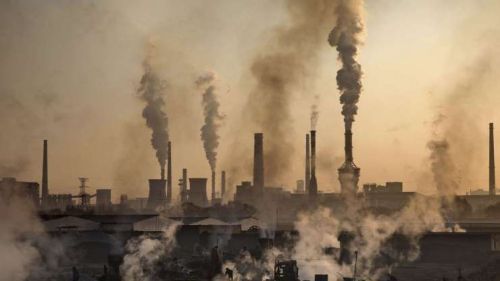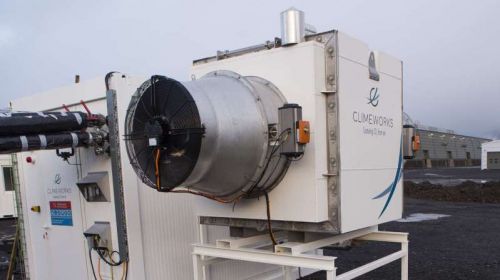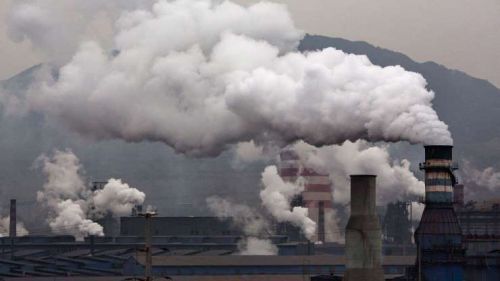本文转自《MSN》发表的题为“Carbon Capture Is Needed to Avoid Catastrophe, Says Dire Climate Report”的报道。
作者:Matt Smith
日期:2018.10.11
原文链接:https://www.msn.com/en-us/weather/topstories/carbon-capture-is-needed-to-avoid-catastrophe-says-dire-climate-report/ar-BBOeq4e
The IPCC's alarming climate change report says that limiting global warming will require unproven carbon dioxide removal technologies.
IPCC令人震惊的气候变化报告称,限制全球变暖将需要未经证实的二氧化碳清除技术。

If you thought the headlines this week about how we only have until 2030 to avert catastrophic climate change were stark, wait until you read the fine print.
如果你认为关于我们如何才能在2030年前避免灾难性的气候变化的头条新闻是赤裸裸的,那就等着瞧吧。
This week’s report from the United Nations’ Intergovernmental Panel on Climate Change says that limiting global warming to 1.5 degrees Celsius (2.7 degrees Fahrenheit) over pre-industrial times will require not only swift, sharp cuts in carbon emissions from human sources, but will also require still-unproven technology to remove heat-trapping carbon dioxide from the atmosphere.
本周联合国政府间气候变化专门委员会的报告称,在工业化时代将全球变暖限制在1.5摄氏度(2.7华氏度),不仅需要迅速,大幅削减人力资源的碳排放,而且还需要尚未经过验证的技术来消除大气中的热量吸收二氧化碳。
This technology would also need to be scaled up and deployed within a decade or so, since the world is roughly two-thirds of the way to that mark already.
这项技术还需要在十年左右的时间内扩大规模并进行部署,因为世界已达到该标志的大约三分之二。
“If you take the science seriously, I think it says you have to pull out all the stops,” Kelly Levin, a climate analyst at the World Resources Institute in Washington, DC, told Seeker.
华盛顿特区世界资源研究所的气候分析师Kelly Levin告诉Seeker说:“如果你认真考虑科学,我认为你必须全力以赴。”
Global average temperatures are currently running around 1 degree over pre-industrial times, the IPCC reported, resulting in more extreme weather, rising sea levels, and diminishing Arctic sea ice. The world is still pumping out nearly 33 billion tons of CO2 and other greenhouse gases every year, even as more renewable energy sources like wind and solar power come online.
IPCC报告称,全球平均气温目前比工业化前时期高1度左右,导致更加极端的天气,海平面上升和北极海冰减少。 尽管风能和太阳能等更多可再生能源上线,但全世界每年仍在输出近330亿吨二氧化碳和其他温室气体。

The 2015 Paris climate accord set a goal of limiting climate change to 1.5 degrees over pre-industrial times if possible — or to 2 degrees at worst — by the end of the century. Beyond that point, scientists warn that the effects of climate change will be disastrous for much of the world.
2015年巴黎气候协议设定了一个目标,即在可能的情况下将气候变化限制在前工业时间的1.5度 - 或者在本世纪末将气候变化限制在最差的2度。 除此之外,科学家们警告说,气候变化的影响对世界大部分地区都是灾难性的。
To hit the 1.5-degree target, we would have to start making drastic cuts now and bring emissions down to a net of zero by mid-century, said the IPCC’s report.
IPCC的报告称,要达到1.5度的目标,我们现在必须开始大幅削减,并在本世纪中叶将排放量降至零。
RELATED: How Sensitive Is Earth’s Climate to Carbon Dioxide Pollution?
相关信息:地球气候对二氧化碳污染有多敏感?
“The report shows we are at the crossroads,” French climate scientist Valerie Masson-Delmotte, an IPCC member, told reporters. “What is going to happen from now until 2030 is critical, especially for CO2 emissions.”
“报告显示我们正处于十字路口,”法国气候科学家,IPCC成员Valerie Masson-Delmotte告诉记者。 “从现在到2030年将发生的事情至关重要,特别是对于二氧化碳排放。”
That’s daunting enough. But nearly every scenario in the U.N. report includes a bit of “overshoot” — a period where global temperatures rise past 1.5 degrees and then fall back to that point by 2100. Carbon removal strategies could help reduce the fever, but the overshoot might inflict “long-lasting and irreversible” damage on vulnerable ecosystems before temperatures stabilize.
这太令人生畏了。 但几乎联合国报告中的每一个场景都包含一些“超调” - 全球气温上升超过1.5度然后在2100年回落到这一时期。碳排除策略可以帮助减少发烧,但过冲可能造成“ 在温度稳定之前,对脆弱生态系统造成的长期和不可逆转的“破坏”。
Removing carbon from the atmosphere could take several forms. The simple, low-tech way would be to plant more trees, which consume carbon dioxide as they grow. Levin’s organization estimates that properly managed forests could absorb enough carbon to offset the emissions from a billion and a half cars.
从大气中去除碳可能有几种形式。 简单,低技术的方法是种植更多的树木,这些树木在生长时会消耗二氧化碳。 Levin的组织估计,妥善管理的森林可以吸收足够的碳来抵消十亿辆汽车的排放。
“That is proven, and certainly they can be managed in ways to do more of that,” Levin noted. Forestry and agriculture would have to be supplemented by industrial processes, she added, but they “can certainly get you a long way there.”
“事实证明,当然,他们可以通过各种方式进行管理,”莱文指出。 她补充说,林业和农业必须通过工业流程加以补充,但他们“肯定会让你在那里走很长的路。”
RELATED: Rising Humidity Due to Climate Change Could Push Humans to Their Physical Limit
相关信息:气候变化导致的湿度上升可能会将人类推向身体极限
Those industrial methods can involve carbon capture and sequestration, which captures carbon dioxide from emitters like fossil fuel power plants and stores it elsewhere. Another idea is to use plant material to produce energy and then capture the carbon emissions released by burning that biomass — a process that’s known as “bioenergy with carbon capture and storage” (BECCS).
这些工业方法可能涉及碳捕获和封存,其捕获来自化石燃料发电厂等排放源的二氧化碳并将其储存在其他地方。 另一个想法是使用植物材料来产生能量,然后捕获燃烧生物质释放的碳排放 - 这一过程被称为“碳捕获和储存的生物能源”(BECCS)。
Yet another method, direct air capture of CO2, would be to capture carbon dioxide from the air using chemicals that bind to it. The captured carbon could be stashed underground or put to use to produce industrial chemicals, fertilizer, and even fuel.
另一种方法是直接空气捕获二氧化碳,即使用与之结合的化学物质从空气中捕获二氧化碳。 捕获的碳可以藏在地下或用于生产工业化学品,肥料甚至燃料。

Gregory Nemet, who studies energy systems and the environment at the University of Wisconsin, said that these technologies hold promise and could be scaled up to remove large volumes of CO2 — but he pointed out that they also “have side effects and concerns.” For instance, a demand for land to grow biomass for energy could end up impacting agriculture for food.
研究威斯康星大学能源系统和环境的Gregory Nemet表示,这些技术具有前景,可以扩大规模以消除大量的二氧化碳 - 但他指出,它们“也有副作用和担忧。” 例如,对生产生物质能源的土地的需求可能最终影响农业用于食品。
“One of the big concerns we have about climate change is food availability, crop yields, and water use, and here we’re talking about a solution that uses water and takes land that’s used for food,” Nemet told Seeker. “Those are things societies are pretty sensitive to, and small disruptions can have really big influences.”
“我们对气候变化的一个重大担忧是粮食供应,作物产量和用水量,在这里我们谈论的是一种使用水并将土地用作食物的解决方案,”Nemet告诉Seeker。 “这些都是社会非常敏感的事情,小的破坏可能会产生很大的影响。”
Both of these carbon-capture technological processes are “in their infancy,” Levin said, and have potential drawbacks that would have to be overcome. The energy needed to suck CO2 out of the sky would need to be carbon-neutral, for instance, to avoid compounding emissions for the sake of absorbing them.
Levin说,这两种碳捕获技术都处于“婴儿期”,并且具有必须克服的潜在缺点。 例如,将二氧化碳从天空中吸出所需的能量需要是碳中性的,以避免为了吸收它们而混合排放。
RELATED: Hacking Earth's Atmosphere Won't Protect Crops From Global Warming
相关信息:破坏地球的大气层无法保护作物免受全球变暖的影响
Meanwhile, at least two companies are already attempting to capture CO2 from the air on an industrial scale. The first, operated by the company Climeworks in Switzerland, went online in 2017 and is aiming to capture 1 percent of global emissions by 2025. The second, based in British Columbia and developed by the company Carbon Engineering, reported in August that it could capture up to a million tons of CO2 at a cost that’s competitive with other renewable energy technologies.
与此同时,至少有两家公司已经尝试以工业规模从空气中捕集二氧化碳。第一个由瑞士Climeworks公司运营,于2017年上线,目标是到2025年占全球排放量的1%。第二个位于不列颠哥伦比亚省,由碳工程公司开发,8月份报告说可以捕获高达一百万吨的二氧化碳,其成本与其他可再生能源技术相比具有竞争力。
This form of direct air capture is harder than sequestering CO2 from industrial facilities, since CO2 in the atmosphere is 100 to 300 times less concentrated than smokestack emissions, according to a 2015 study by the National Academy of Sciences. But Nemet said that the biggest issue with sucking carbon out of the sky has been the cost, which the companies working on these projects say has fallen from around $600 a ton to less than $100 a ton in some cases.
与此同时,至少有两家公司已经尝试以工业规模从空气中捕集二氧化碳。第一个由瑞士Climeworks公司运营,于2017年上线,目标是到2025年占全球排放量的1%。第二个位于不列颠哥伦比亚省,由碳工程公司开发,8月份报告说可以捕获高达一百万吨的二氧化碳,其成本与其他可再生能源技术相比具有竞争力。
“They’d have to scale up really fast,” Nemet said. He estimated that Climeworks’ goal of removing 1 percent of CO2 by 2025 would require building about 600,000 of the current small-scale plants.
“他们必须迅速扩大规模,”Nemet说。他估计Climeworks的目标是到2025年消除1%的二氧化碳,这需要建造大约60万个目前的小型工厂。
“In a way, that seems impossibly large. They’d have to triple the output of their plants every year,” he said. But, Nemet added, “It’s not out of the ballpark. It would be about twice as fast as solar has scaled up.”
“在某种程度上,这似乎是不可能的。 他们必须每年将工厂的产量增加两倍,“他说。 但是,Nemet补充说,“它并没有脱颖而出。 这将是太阳能扩大规模的两倍。“
And if other companies follow suit, gigatons of CO2 removal may well be within reach.
如果其他公司也效仿,那么二氧化碳排放的数量很可能就会达到。

Others are less enthusiastic about these prospects. Some, like Richard Heinberg of the Post Carbon Institute, see them as quixotic efforts that distract from the reality of curbing economic growth for the sake of reliably reducing emissions.
其他人对这些前景不那么热衷。 有些人,如后碳研究所的理查德海因伯格,将其视为不切实际的努力,为了可靠地减少排放而分散了抑制经济增长的现实。
University of Pennsylvania climatologist Michael Mann told Seeker that hitting the 1.5-degree target is “extremely difficult, if not impossible,” while even the 2-degree target remains “an uphill challenge.” Reducing emissions and speeding up the use of renewable energy, he said, are a better bet than negative emissions.
宾夕法尼亚大学气候学家Michael Mann告诉Seeker,达到1.5度目标是“非常困难,即使不是不可能”,而即使是2度目标仍然是“一个艰难的挑战。”减少排放并加速可再生能源的使用, 他说,比负面排放更好。
“The only true techno-fix would be a time machine, or large numbers of reflective white unicorns,” Mann remarked. “I wish the IPCC would emphasize the importance of massive near-term reductions in carbon emissions rather than unproven, kick-the-can-down-the-road technology.”
“唯一真正的技术修复是时间机器,或大量的反光白色独角兽,”曼恩评论道。 “我希望IPCC能够强调近期大规模减少碳排放的重要性,而不是未经证实的,可以采取行动的技术。”
RELATED: This Metal Can Convert Atmospheric CO2 Into Liquid Fuel
相关信息:这种金属可以将大气中的二氧化碳转化为液体燃料
Levin said carbon-removal technology isn’t a “silver bullet,” but it could have other benefits — including boosting the use of renewables to produce the necessary energy. And so far, policymakers aren’t using the prospects as an excuse to avoid cutting fossil fuel use.
Levin说碳去除技术不是“银弹”,但它可以带来其他好处 - 包括增加可再生能源的使用以产生必要的能量。 到目前为止,政策制定者并没有将前景作为避免削减化石燃料使用的借口。
But given the news from the UN this week, she said, “it’s important to start understanding how we can scale this in the very near future.”
但鉴于联合国本周的消息,她说,“重要的是要开始了解我们如何在不久的将来扩大规模。”